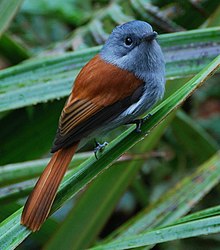Monarch flycatcher
| Monarchidae | |
|---|---|
 |
|
| Mascarene paradise flycatcher | |
| Scientific classification | |
| Kingdom: | Animalia |
| Phylum: | Chordata |
| Class: | Aves |
| Order: | Passeriformes |
| Suborder: | Passeri |
| Family: |
Monarchidae Bonaparte, 1854 |
| Subfamilies | |
|
|
The monarchs (family Monarchidae) comprise a family of over 100 passerine birds which includes shrikebills, paradise flycatchers, and magpie-larks.
Monarchids are small insectivorous songbirds with long tails. They inhabit forest or woodland across sub-Saharan Africa, south-east Asia, Australasia and a number of Pacific islands. Only a few species migrate. Many species decorate their cup-shaped nests with lichen.
Some of the one hundred or more species making up the family were previously assigned to other groups, largely on the basis of general morphology or behaviour. The magpie-lark, for example, was assigned to the same family as the white-winged chough, since both build unusual nests from mud rather than vegetable matter.
With the new insights generated by the DNA-DNA hybridisation studies of Sibley and his co-workers toward the end of the 20th century, however, it became clear that these apparently unrelated birds were all descended from a common ancestor: the same crow-like ancestor that gave rise to the drongos. On that basis they were previously included as a subfamily of the Dicruridae, along with the fantails, although it is now treated at familial rank as Monarchidae.
More recently, the grouping has been refined somewhat as the original concept of Corvida has proven paraphyletic. The narrower 'Core corvine' group now comprises the crows and ravens, shrikes, birds of paradise, fantails, monarchs, drongos and mudnest builders.
The monarchs are small to medium-sized insectivorous passerines, many of which hunt by flycatching.
The monarch family has sixteen extant genera as follows:
FAMILY MONARCHIDAE
The monarchs are a diverse family of passerine birds that are generally arboreal (with the exception of the magpie-larks). They are mostly slim birds and possess broad bills. The bills of some species are quite large and the heavy-set bills of the shrikebills are used to probe dead wood and leaves. The plumage of the family ranges from sombre, such as the almost monochrome black monarch, to spectacular, as displayed by the golden monarch. The tails are generally long and spectacularly so in the paradise flycatchers in the genus Terpsiphone. Sexual dimorphism in plumage can be subtle, as in the paperbark flycatcher, where the female is identical to the male except for a slight buff on the throat; striking, as in the Chuuk monarch where the male almost entirely white and the female entirely black; or non-existent, as in the Tahiti monarch. In some species, for example the Malagasy paradise flycatcher, the males have two or more colour morphs.
...
Wikipedia
